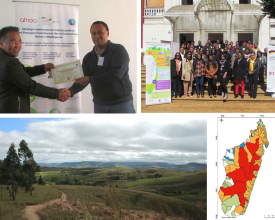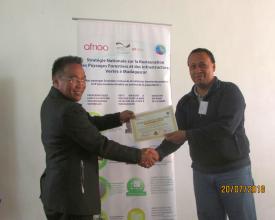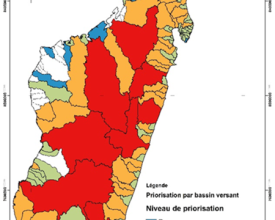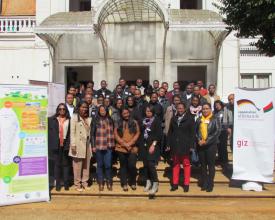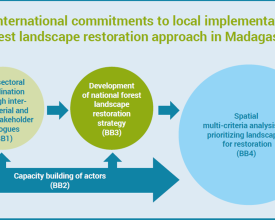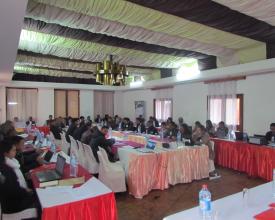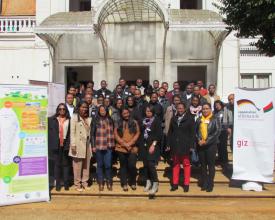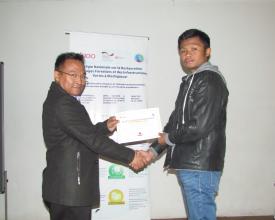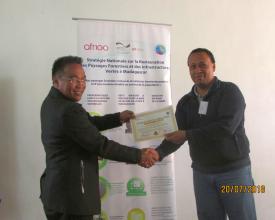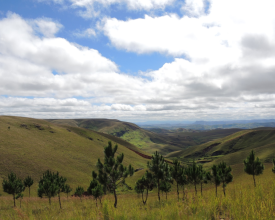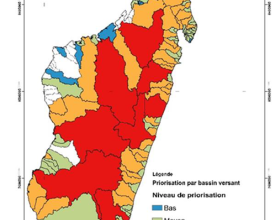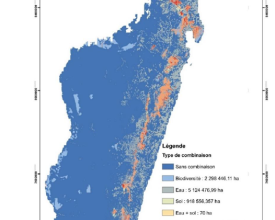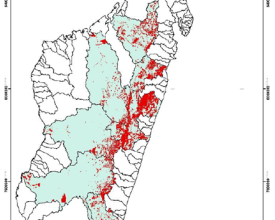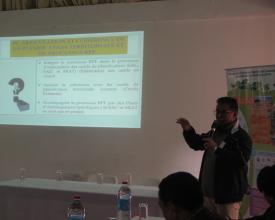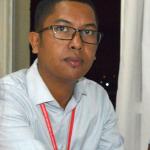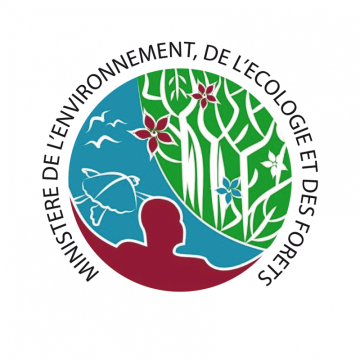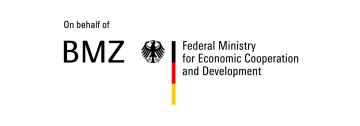
De los compromisos internacionales a la aplicación local: el enfoque de restauración del paisaje forestal en Madagascar
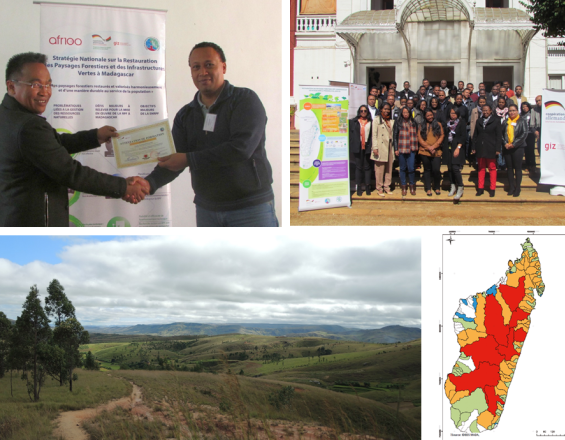
El bienestar de la población de Madagascar depende de sus recursos naturales y sus bienes, como la leña, los alimentos y el agua. Muchas zonas están muy degradadas debido al uso insostenible de la tierra. Los peligros climáticos añaden más riesgos para las personas, la naturaleza y toda la economía. La restauración del paisaje forestal (FLR) es una prioridad clave del AFR100 para garantizar el desarrollo sostenible. Sus pilares son unos ecosistemas resistentes y multifuncionales que mejoren la economía, la seguridad alimentaria y el suministro de agua, la protección de la biodiversidad y la captura de carbono. Es crucial pasar rápidamente de las promesas a la aplicación práctica. Esta solución describe este exitoso proceso, que abarca el establecimiento de plataformas de múltiples partes interesadas, medidas de capacitación de los actores, desarrollo de una estrategia nacional de FLR y priorización de áreas sobre la base de una evaluación multicriterio. Entre los próximos pasos se incluirá la identificación de lugares para llevar a cabo actividades piloto de restauración en la región de Boeny.
Contexto
Défis à relever
La elevada demanda de alimentos y leña provoca la deforestación y la degradación de la tierra, con la consiguiente erosión del suelo, pérdidas de productividad y falta de regulación del agua. Los peligros adicionales del cambio climático agravan la degradación medioambiental y los riesgos para los medios de vida de las personas (retos medioambientales y sociales).
La mayoría de las políticas abordan la productividad de la tierra, pero las acciones locales no están bien coordinadas; faltan funciones y responsabilidades claras del sector público y la sociedad civil. Sigue predominando el solapamiento de los derechos de uso de la tierra y el pensamiento de silo. El marco institucional para la gestión de los recursos naturales es inadecuado, faltan conocimientos pertinentes y recursos personales y financieros. Las necesidades y los retos del desarrollo limitan las opciones de uso del suelo (retos de gobernanza).
Existen buenas prácticas de restauración del paisaje a nivel local, pero estas iniciativas son muy específicas de cada lugar y carecen de financiación sostenible para ampliarlas a un nivel más amplio (problemas técnicos).
Ubicación
Procesar
Resumen del proceso
La creación del comité y la plataforma nacionales de RPF como estructuras institucionales para la coordinación y el diálogo entre múltiples partes interesadas (BB1) fue la base para pasar de la promesa de RPF a las políticas y la planificación de la restauración. El desarrollo de capacidades (BB2) se llevó a cabo a lo largo de todo el proceso para apoyar el desarrollo de la estrategia nacional de restauración del paisaje forestal (BB3) como documento marco para la posterior identificación y priorización de paisajes para la restauración mediante el análisis espacial multicriterio (BB4).
Bloques de construcción
Coordinación intersectorial mediante diálogos interministeriales y entre múltiples partes interesadas
Se creó un comité nacional multidisciplinar de FLR como consejo asesor, facilitando la coordinación intersectorial e interministerial para pasar de la promesa de FLR a políticas y acciones concretas. Está formado por 15 personas, incluidos los ministerios de Medio Ambiente, Agricultura, Energía y Agua, Ordenación del Territorio y representantes de la sociedad civil y el sector privado.
Abarca cinco grupos de trabajo que se ocupan de i) la gestión forestal, ii) el agua, iii) la agricultura, vi) la financiación y v) la gestión del suelo. Valida todas las decisiones clave. Sus miembros también participan, como especialistas, en actividades de capacitación técnica.
El comité llevó a cabo una evaluación de las necesidades de las partes interesadas y de las capacidades, un análisis de la financiación y facilitó varios diálogos entre múltiples partes interesadas, por ejemplo para el desarrollo de la estrategia nacional de restauración del paisaje forestal, y garantiza que se tengan en cuenta los intereses de las partes interesadas.
La plataforma FLR es un foro de diálogo entre múltiples partes interesadas con más de 50 miembros, dirigido por el comité FLR, para debatir, proponer y validar soluciones prácticas para la restauración del paisaje forestal a nivel regional y local y apoyar la aplicación de la estrategia FLR y el desarrollo de capacidades.
Factores facilitadores
- El punto focal de FLR fue nombrado inmediatamente después del compromiso AFR100 en 2015, para liderar el proceso; fue la persona clave y una fuerza impulsora, debido a la muy buena red con diferentes ministerios y grupos de partes interesadas, actuando como intermediario de conocimiento institucional, creador de redes, manteniendo el impulso político.
- Fuerte sincronización de diferentes conceptos, coherencia política gracias a la interacción entre los puntos focales responsables de diferentes compromisos, como los manglares, la CNULD, etc.
Lección aprendida
- Fue crucial acordar una definición común de "paisaje" como unidad de cuenca hidrográfica; los actores lo utilizaron de formas muy diferentes en el pasado
- La ordenación territorial existente sólo abarca las divisiones administrativas, mientras que el enfoque paisajístico utiliza las divisiones de las cuencas hidrográficas. Fue necesario consultar al Ministerio de Planificación para adoptar el enfoque paisajístico y los resultados de esta solución en el plan espacial nacional
- La FLR es un concepto de paisaje multisectorial, que integra a diversas partes interesadas; al principio, la plataforma sólo se centraba en el sector forestal y medioambiental. Fue crucial "abrirse" a otros sectores, como la ordenación territorial y el agua.
- La reestructuración del comité era pertinente para reflejar las prioridades de la FLR, como la tenencia de la tierra, el agua, la rehabilitación del suelo y garantizar el desarrollo de capacidades.
- El establecimiento de subgrupos temáticos (suelo, tenencia de la tierra, agua, bosques) permitió una mejor operatividad.
- El alto nivel de participación de las distintas partes interesadas garantizó la legitimidad de los resultados.
Refuerzo de las capacidades de los agentes
Se llevó a cabo una serie de cursos de formación para los responsables de la toma de decisiones a nivel nacional, en los que se trataron temas como los términos y definiciones de la FLR, las estrategias para hacer frente a los factores de degradación (por ejemplo, la dendroenergía) y las opciones de financiación. El desarrollo de capacidades se llevó a cabo de forma continua y tuvo un carácter de "formación en el puesto de trabajo"; se alineó con aspectos concretos como los estudios de FLR (estudio ROAM, opciones de financiación), la estrategia nacional de FLR y la identificación de paisajes prioritarios de FLR. ~Aproximadamente 40 actores relevantes (universidades, sociedad civil, sector privado) pudieron hacer sus aportes en forma de cuestionarios sobre cómo definir las áreas prioritarias para la FLR, lo que constituyó una piedra angular del desarrollo de capacidades.
La formación se complementó con la participación de representantes nacionales en diversas conferencias regionales e internacionales sobre FLR y AFR100, lo que permitió un mayor intercambio de conocimientos a escala mundial para mejorar las estrategias nacionales.
En la actualidad, el desarrollo de capacidades se centra en el ámbito regional; se ha desarrollado un módulo de formación que se puso a prueba en la región de Boeny en abril de 2018 y se adaptará para su aplicación en la región de Diana. Se impartirán formaciones adicionales para el Ministerio de Ordenación del Territorio, que abarcarán la gobernanza de la tierra.
Factores facilitadores
- Se realizó y completó una evaluación de las partes interesadas y las necesidades de capacidad (06/2016)
- La gran experiencia personal y las habilidades técnicas de los miembros del Comité Nacional de la RPF fueron grandes activos para el desarrollo de capacidades. Actuaron como formadores y no fue necesario recurrir a expertos externos.
- Alto compromiso político por parte de los socios
- Apoyo de BIANCO (agencia nacional independiente de lucha contra la corrupción) para mejorar la transparencia en el sector forestal (hasta finales de 2016)
Lección aprendida
- La formación y los intercambios periódicos ayudaron a crear un entendimiento común sobre el concepto de RPF como enfoque multisectorial del paisaje y su aplicación práctica en Madagascar a nivel político, estratégico y práctico.
- Fue crucial aumentar los conocimientos sobre el enfoque de RPF basándose en los debates internacionales y las realidades locales. Cada actor tenía su propia definición de "paisaje"; el desarrollo de capacidades sobre el enfoque resultó esencial para garantizar el mismo nivel de información para todas las partes interesadas, especialmente las de sectores distintos del medio ambiente.
- El aspecto innovador fue que los miembros del Comité Nacional dedicaron mucho tiempo y también participaron activamente en el desarrollo de módulos de formación y capacitación.
- La puesta en práctica del desarrollo de capacidades fue muy participativa y los participantes mejoraron continuamente el contenido, adaptando también el "lenguaje" de sectores clave como la planificación del uso del suelo y las finanzas
Desarrollo de una estrategia nacional de restauración del paisaje forestal
La estrategia nacional para la restauración del paisaje forestal y la infraestructura verde se desarrolló de forma participativa durante 8 meses en varias fases:
1) definición del alcance a nivel de comité y redacción de los términos de referencia, selección de asesores
2) validación de la metodología
3) consulta del gobierno, la sociedad civil y el sector privado a nivel regional (10 de 22 regiones),
4) 2 talleres de validación a nivel nacional para el comité y la plataforma,
5) comunicación de la estrategia a nivel del Consejo de Ministros (reunión de todos los Ministros y Primeros Ministros)
6) difusión en el sitio web del Ministerio de Medio Ambiente y Bosques.
La estrategia hace balance de la situación actual y las condiciones marco en Madagascar, analiza los principales retos para alcanzar el objetivo de 4 millones de hectáreas para 2030 y ofrece asesoramiento estratégico sobre cómo superarlos y movilizar a los actores clave.
La estrategia recomienda prioridades que abarcan la buena gobernanza, la planificación espacial coherente, las medidas técnicas de restauración y la movilización de recursos. Las prioridades se desglosan en 12 objetivos y actividades concretas.
Factores facilitadores
- Un estudio sobre oportunidades de FLR -siguiendo la metodología de Mapeo de Oportunidades de Restauración de la UICN- de 2015 sirvió de base técnica.
- El desarrollo de la estrategia coincidió con la revisión de la "nueva Política Forestal" del Ministerio de Medio Ambiente y Bosques. La FLR es una prioridad clave de esta nueva política forestal
- Una nueva política energética nacional apoya la aplicación de la estrategia de FLR mediante una restauración de 40.000 ha de bosques y plantaciones forestales al año para el suministro de energía rural doméstica
Lección aprendida
- Era crucial que la estrategia mencionara abiertamente los retos y el potencial de mejora, incluyendo también las cuestiones de los derechos (de tenencia) de la tierra, la actual falta de cooperación intersectorial y la débil gobernanza, lo que reflejaba la conciencia de los problemas existentes.
- Para su aceptación y legitimidad, era crucial desarrollar los elementos clave de la estrategia en un proceso participativo junto con el comité de FLR.
- Lo ideal era que la estrategia fuera validada oficialmente por un decreto interministerial en el que participaran los sectores clave; pero esto no era suficiente y, además, era necesario un largo proceso de presión dentro de los poderosos ministerios clave implicados. Integrar a los Secretarios Generales de los Ministerios de Agricultura y Ordenación del Territorio en el Comité de la FLR fue la solución para integrar la estrategia.
Análisis espacial multicriterio para priorizar la restauración de paisajes
El enfoque se centró en 3 funciones esenciales de los ecosistemas: agua, biodiversidad y suelo. Para definir los criterios de cada grupo se siguieron los siguientes pasos:
- Identificación de parámetros y criterios relevantes para los servicios ecosistémicos (> 100 criterios)
- Preselección: espacialización de parámetros a escala nacional, regional y local (41 criterios espacialmente disponibles)
- Consulta: selección de los criterios finales basados en 3 grupos (agua, biodiversidad, suelo) durante el trabajo en grupo, consultas directas; priorización, ponderación de indicadores y determinación de los valores de los criterios (28 criterios priorizados). Ejemplos de criterios: precipitaciones, recursos hidrológicos, densidad de población, uso del suelo, carbono y productividad del suelo.
- Análisis multicriterio basado en valores cuantitativos y cualitativos; preparación de 14 mapas de escenarios, combinando diferentes grupos (agua, biodiversidad y suelo) con cuatro niveles de prioridad; identificación de un área prioritaria de 11.122.540 ha.
- Verificación de los resultados a partir de los datos del estudio nacional sobre el método de evaluación de las oportunidades de restauración (ROAM) y otras fuentes.
- Validación de los resultados por el comité y la plataforma nacionales de FLR y selección de 8 cuencas prioritarias
Factores facilitadores
- Documentos de política y planificación existentes que definen las oportunidades generales de FLR
- Análisis de las opciones de financiación y las oportunidades de participación del sector privado en la FLR (finalizado en 05/2017)
- Plataforma de diálogo sobre FLR y gran interés y movilización de actores
- Pasar de un enfoque centrado en el ecosistema forestal a un enfoque ecosistémico a nivel de paisaje que integre la prevención de la erosión y el suministro de agua
- El uso habitual de la tierra ya no era una opción, ya que los ecosistemas estaban muy degradados.
Lección aprendida
- La identificación de 3 grupos distintos de funciones ecosistémicas (agua, biodiversidad, suelo) ayudó a las partes interesadas de diferentes sectores e instituciones a comprender su propio papel y espacio de acción en este proceso.
- La consulta exhaustiva y la implicación de 38 organizaciones diferentes fue clave para priorizar las áreas de restauración de forma transparente y participativa y para crear un consenso sobre la decisión final.
- Fue crucial alcanzar un consenso político sobre la distribución geográfica más equilibrada de las zonas prioritarias de 4 millones de hectáreas.
- El proceso ayudó a establecer una definición oficial de las cuencas hidrográficas, distinguiendo 159 cuencas hidrográficas.
- El proceso fue muy técnico, pero desencadenó una intensa reflexión política porque se utilizó un enfoque holístico del paisaje para la planificación y la toma de decisiones y reveló un enorme potencial para la FLR.
- Las decisiones también se guiaron por las políticas actuales del sector energético y medioambiental para garantizar la coherencia.
Impactos
- Los responsables de la toma de decisiones perciben la FLR como un enfoque holístico del paisaje que aumenta la productividad del paisaje, la seguridad alimentaria, el acceso al agua, la resiliencia al cambio climático y preserva la biodiversidad.
- Se ha fortalecido significativamente la gobernanza de la tierra, incluida la coordinación intersectorial a nivel nacional.
- Se han fortalecido las capacidades de las partes interesadas nacionales en materia de RPF, desde la formulación de políticas nacionales hasta la identificación práctica de paisajes para la restauración; se ha contribuido a planificar los recursos técnicos y financieros existentes en un área espacialmente definida; se ha tomado conciencia de la necesidad de cooperación multisectorial para implementar actividades de RPF de manera sostenible.
- Se aprovecharon las sinergias con otras políticas (como la de energías renovables a través del suministro de leña);
- Se están desarrollando nuevas políticas sectoriales con un mayor sentido de la coherencia entre los diferentes enfoques y conceptos (por ejemplo, la directiva nacional de reforestación).
- Se ha reforzado significativamente la concienciación política sobre el enfoque de FLR, así como el impulso político para la restauración.
En la región de Boeny se estableció un "paisaje piloto de FLR" con un diálogo entre múltiples actores que abarca la restauración desde diferentes ángulos temáticos (tenencia de la tierra, protección del suelo, restauración) y los primeros pasos para pasar del nivel nacional al regional.
Beneficiarios
- Ministerios nacionales (MEEF, MATSF, MINAE, MEAH) y oficinas regionales
- Diferentes miembros del comité nacional de FLR
- Servicios de extensión subnacionales
- Organizaciones de la sociedad civil y comunidades locales
Objetivos de Desarrollo Sostenible
Historia
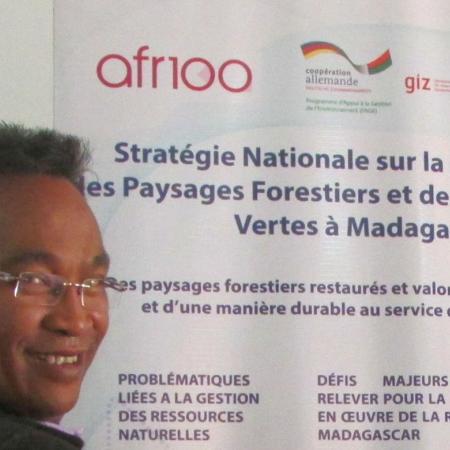
Por Julien Noel Rakotoarisoa, Punto Focal de FLR, (Ministerio de Medio Ambiente, Ecología y Bosques (MEEF), Madagascar)
La evolución del proceso de restauración del paisaje forestal ha avanzado notablemente en Madagascar desde la declaración de compromiso del país de restaurar 4 millones de hectáreas de tierras y bosques degradados de aquí a 2030. De hecho, la fase preparatoria se abordó con la incesante coordinación del Ministerio encargado de los bosques, que gestiona el proceso con el apoyo del Programa germano-malgache de gestión sostenible del medio ambiente (PAGE), ejecutado en cooperación con la GIZ.
La clave del éxito de la puesta en marcha del proceso de FLR residió en la naturaleza dinámica de nuestro comité nacional multisectorial de FLR, en el que también participan diversos actores de diferentes sectores y ámbitos; esto ayudó a garantizar una planificación holística del uso de la tierra teniendo en cuenta los intereses de cada grupo de actores a través del enfoque de servicios ecosistémicos específicos de las futuras acciones de restauración.
Además, fue clave el desarrollo de un programa de formación sobre el enfoque paisajístico, la gestión de los recursos naturales y la planificación del uso del suelo, seguido de la organización de sesiones de capacitación sobre estos temas; se basó realmente en la petición de los sectores implicados. Esto da mucho optimismo para abordar la fase crítica hacia el paso de la planificación actual a la fase operativa ya marcada por los proyectos piloto de aplicación del proceso de FLR en nuestro país.

